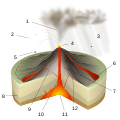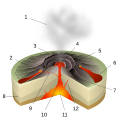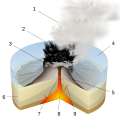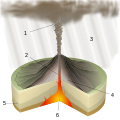Types of volcanic eruptions
This article needs additional citations for verification. (February 2010) |
During a volcanic eruption, lava, tephra (ash, lapilli, solid chunks of rock), and various gases, are expelled from a volcanic vent or fissure.
Several types of volcanic eruptions have been distinguished by volcanologists. These are often named after famous volcanoes where that type of behavior has been observed. Some volcanoes may exhibit only one characteristic type of eruption during a period of activity, while others may display an entire sequence of types.
Eruption mechanisms
Volcanic eruptions arise through three main mechanisms:
- Gas release under decompression causing magmatic eruptions
- Thermal contraction from chilling on contact with water causing phreatomagmatic eruptions
- Ejection entrained particles during steam eruptions causing phreatic eruptions (Heiken & Wholtez 1985)
Magmatic eruptions
Magmatic eruptions produce juvenile clasts during explosive decompression from gas release. They range in size from the relatively small fire fountains on Hawaii to >30 km Ultra Plinian eruption columns, bigger than the eruption that buried Pompeii. (Heiken & Wohletz 1985)
Strombolian
Strombolian eruptions are named because of activity of Stromboli in Sicily. They are characterised by huge clots of molten lava bursting from the summit crater to form luminous arcs through the sky. Collecting on the flanks of the cone, lava clots combine to stream down the slopes in molten rivulets. The explosions are driven by bursts of gas slugs that rise faster than surrounding magma.[1]
Vulcanian
Vulcanian eruptions are named after Vulcano, following Giuseppe Mercalli's observations of its 1888-1890 eruptions. Another example was the eruption of Parícutin in 1947. They are characterised by a dense cloud of ash-laden gas exploding from the crater and rising high above the peak. Steaming ash forms a whitish cloud near the upper level of the cone.
Peléan
In a Peléan eruption or nuée ardente (glowing cloud) eruption, such as occurred on the Mayon Volcano in the Philippines in 1968, a large amount of gas, dust, ash, and lava fragments are blown out of a central crater, fall back, and form avalanches that move downslope at speeds as great as 160 km per hour. Such eruptive activity can cause great destruction and loss of life if it occurs in populated areas, as demonstrated by the devastation of Saint-Pierre during the 1902 eruption of Mont Pelée on Martinique, Lesser Antilles, from which Peléan eruptions are named.
Hawaiian
Hawaiian eruptions may occur along fissures or fractures that serve as vents, such as during the eruption of Mauna Loa Volcano in Hawaii in 1950. Also, they can occur at a central vent, such as during the 1959 eruption in Kilauea Iki Crater of Kilauea Volcano, Hawaii. In fissure-type eruptions, lava shoots from a fissure on the volcano's rift zone and feeds lava streams that flow downslope. In central-vent eruptions, a lava fountain is erupted to a height of several hundred meters or more. Such lava may collect in old pit craters to form lava lakes, or form cones, or feed radiating flows.
Surtseyan
A Surtseyan eruption occurs in shallow seas or lakes. It is named after the island of Surtsey off the southern coast of Iceland.[2]
Plinian
Plinian eruptions are usually the most powerful, and involve the explosive ejection of relatively viscous lava. Large plinian eruptions — such as during 18 May 1980 at Mount St. Helens or, more recently, during 15 June 1991 at Pinatubo in the Philippines— can send ash and volcanic gas tens of kilometres into the atmosphere. The resulting ash fallout can affect large areas hundreds of miles downwind. Fast-moving pyroclastic surges and pyroclastic flows together with “nuées ardentes,” are often associated with plinian eruptions.
Phreatomagmatic eruptions
Phreatomagmatic eruptions are the result of thermal contraction from chilling on contact with water. The products of phreatomagmatic eruptions are believed to have more regular shard shapes and be finer grained than the products of magmatic eruptions because of the different eruptive mechanism.
There is debate about the exact nature of the eruptive style. Fuel-coolant reactions may be more critical to the explosive nature than thermal contraction (Starostin et al. 2004). Fuel coolant reactions fragment the material in contact with a coolant by propagating stress waves widening cracks and increasing surface area leading to rapid cooling rates and explosive thermal contraction (Heiken & Wohletz 1985).
Submarine
A submarine eruption is a type of volcanic eruption where lava erupts under an ocean. Most of the Earth's volcanic eruptions are submarine eruptions, but few have been documented because of the difficulty in monitoring submarine volcanoes. Most submarine eruptions occur at mid-ocean ridges.
Subglacial
Subglacial eruptions are named because of activity under ice, or under a glacier. They can cause dangerous floods, lahars, and create hyaloclastite and pillow lava. Only five of these types of eruptions have occurred in the present day.
Antarctica eruption
In 2008, the British Antarctic Survey (BAS) scientists led by Hugh Corr and David Vaughan reported (in the journal Nature Geoscience) that a volcano erupted under Antarctica ice sheet 2,200 years ago. They believed this was the biggest eruption in Antarctica in the last 10,000 years. The volcanic ash was identified through a airborne radar survey, which found an ash layer buried under later snowfalls in the Hudson Mountains, close to Pine Island Glacier.[3]
Phreatic eruptions
Phreatic eruptions (or steam-blast eruptions) are driven by explosive expanding steam resulting from cold ground or surface water coming into contact with hot rock or magma. The distinguishing feature of phreatic explosions is that they only blast out fragments of pre-existing solid rock from the volcanic conduit; no new magma is erupted. Phreatic activity is generally weak, but has been known to be strong, such as the 1965 eruption of Taal Volcano, Philippines, and the 1975-1976 activity at La Soufrière, Guadeloupe (Lesser Antilles).
Vents
Volcanoes do not always erupt vertically from a single crater near their peak; some volcanoes exhibit lateral and fissure eruptions. The Laki fissure and the Reykjanes crater row[4] in Iceland are examples.
Diagrams of eruption types
-
Strombolian eruption
-
Vulcanian eruption
-
Pelean eruption
-
Hawaiian eruption
-
Surtseyan eruption
-
Submarine eruption
-
Subglacial eruption
-
Plinian eruption
-
Phreatic eruption
Ten deadliest volcanic eruptions
| Death Toll | Event | Standort | Date |
|---|---|---|---|
| 92,000 | Mount Tambora (see also Year Without a Summer) | Indonesien | 1815 |
| 36,000 | Krakatoa | Indonesien | August 26–27, 1883 |
| 29,000 | Mount Pelée | Martinique | May 7 or May 8, 1902 |
| 23,000 | Nevado del Ruiz | Kolumbien | November 13, 1985 |
| 25,000 | Mount Vesuvius | Italien | August 24th 79 AD |
| 15,000 | Mount Unzen | Japan | 1792 |
| 10,000 | Mount Kelut | Indonesien | 1586 |
| 9,350 | Laki. Killed about 25% of the population (33% were killed about 70 years before by smallpox) | Island | June 8, 1783 |
| 6,000 | Santa Maria | Guatemala | 1902 |
| 5,115 | Mount Kelut | Indonesien | May 19, 1919 |
Notes
A supervolcanic eruption at Lake Toba around 74,000 years ago could have wiped out as much as 99% of the global human population, reducing the population from a possible 60 million to less than 10 thousand; see Toba catastrophe theory. However, this theory is not widely accepted because the evidence is disputed, and there have been, for instance, no remains found. The eruption is not listed here as it was pre-historic and outside the scope of this article. Also, the Thera eruption in the Aegean Sea between 1550 and 1650 B.C. may have caused a large number of deaths throughout the region, from Crete to Egypt. See also La Garita Caldera, Yellowstone Caldera, and Supervolcanoes.
See also
References
Further reading
- Heiken, G. & Wohletz, K. 1985. Volcanic Ash. University of California Press, Berkeley.
- Starostin, A. B., Barmin, A. A. & Melnik, O.E. 2005. A transient model for explosive and phreatomagmatic eruptions. Journal of Volcanology and Geothermal Research, 143, 133-151.
- Pyle, D. M. 1989. The thickness, volume and grainsize of tephra fall deposits. Bulletin of Volcanology, 51, 1-15.
- Riley, C. M., Rose, W. I. & Bluth, G.J.S. 2003. Quantitive shape measurements of distal volcanic ash. Journal of Geophysical Research, 108, B10, 2504.
External links
- Volcanic Eruption Guide for children and youth
- USGS Hawaiian Volcano Observatory (HVO) accessed June 19, 2007.
- Images of the eruption of Chaitén volcano, 2008









